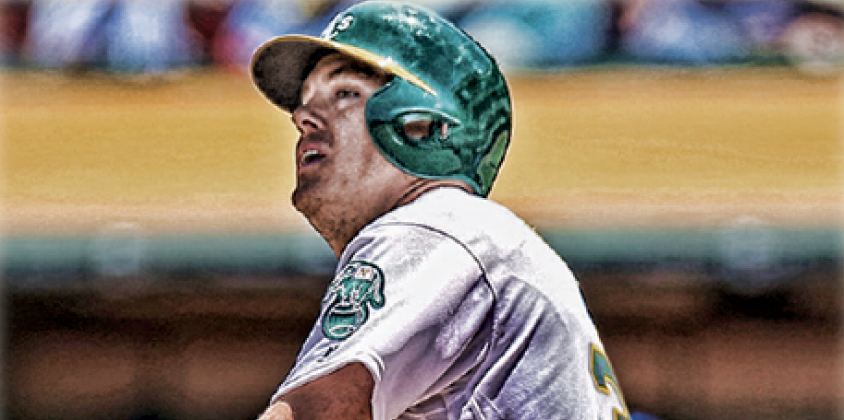Since the offseason began, the Oakland Athletics have been saying that they planned to move Khris Davis to their DH spot on more of a full time basis, a view that was cemented when the team traded away Ryon Healy to the Seattle Mariners in exchange for some relief help. While the Winter Meetings are in their final day, the baseball world is still awaiting a major deal or two to whet our appetites, so in the meantime lets look back at this move and how much it has helped the A’s in the quest for a wild card spot in 2018.
Ryan Healy went from batting .285 with a .318 on-base percentage in Class A Stockton in 2014 in a league that is notorious for being hitter-friendly (Matt Olson knocked 37 homers in Stockton that same year), to batting .318 with a .362 OBP through 49 games in Triple-A in 2016 en route to his midseason call-up to Oakland. He bashed 13 homers and hit .305 in the team’s final 72 games and looked like a potential building block for the club following his rookie campaign.
In 2017 the power continued with 25 dingers (he hit 27 across three levels the previous year) and hit a modest .272. On a rebuilding team like the A’s, there would surely be room for him to flourish. Well, there was until third baseman Matt Chapman and first baseman Matt Olson, “The Matts”, made their presence known. Chapman is a superb defender at the hot corner and according to FanGraphs, he was responsible for saving 19 runs, a total that ranked him seventh in the category among all big leaguers over the course of the entire season. Nolan Arenado, the Gold Glove third baseman of the Colorado Rockies finished with a DRS of 20, just one higher than Chapman, in 616 more innings. Chapman and his glove are special, folks.
Matt Olson burst onto the scene by obliterating baseballs and racking up 24 homers in 216 plate appearances. He also tallied 23 homers in Triple-A, giving him a Khris-esque 47 blasts on the season. While Olson’s glove wasn’t on par with his Matt counterpart (spoiler: nobody’s was), he did save four runs in 349 2/3 innings, three more than Healy in roughly 40 more innings.
With the emergence of the two Matts, Ryon Healy became expendable, especially with the plan to move Khris Davis out of left field.
So what will the move of Davis from left to DH mean for the A’s? According to Baseball Reference’s version of defensive WAR, Davis’ glove ranked him in the bottom five among all defenders with a -2.1 dWAR. His oWAR ended up at 3.9, and while oWAR + dWAR doesn’t add up to make a player’s total WAR value, it does give us some sense of each facet of a player’s game.
So with the Oakland Athletics deciding to move Davis out of the field, they’re essentially adding a couple of wins (analytically speaking) through addition by subtraction. And this doesn’t even take into account the eventual left fielder next season. If that player ends up being around a league average bat with solid defense, then the A’s are looking at a potential five win increase on paper. Add in Emilio Pagan (the reliever acquired in the Healy deal), and all of a sudden this one small trade to begin the offseason could have a huge swing in the overall projection of the 2018 season.
The rumor right now is that the A’s and Cardinals have been talking about a deal involving 26-year-old outfielder Stephen Piscotty, who is coming off a down season in St. Louis. That down year saw him hit .235 with a .342 OBP and a wRC+ of 92, eight points below league average. At his peak in 2015, Piscotty was 34 percent better than league average at the dish, though in just 62 games played. In his first full big league season the following year he hit .273 with a .343 OBP, held a wRC+ of 116 and finished with an fWAR of 2.8.
While moving Davis out of left opens up that spot on the field, Piscotty has been much better defensively while manning right, holding a DRS of 8 across 816 2/3 innings last season. In left, he managed a DRS of -4 in a little less than half as many innings.
The good news here is that Matt Joyce, the projected right fielder at the moment, would seemingly benefit from swapping corners, too. In 907 right field innings, he held a DRS of -8, and while the sample size is much smaller he had a DRS of 2 in left field in 157 1/3 innings.
As a team the A’s had a DRS of -4 from right fielders last season, and if Piscotty played the majority of the time over there (which he would, barring injury), then that would take them from ranked 19th in baseball at the position to 7th. Similarly, removing Davis from left and replacing him with Joyce, even if he is just league average over there, would result in a jump from 27th to at least the middle of the pack.
And just to bring this full circle, Ryon Healy, whom the A’s fan base was sad to see go, was exactly league average last season at the dish. Piscotty, in a down year, was just eight points behind him on offense, has roughly the same ceiling with the bat, but can also play in the field as an above average defender.
Of course, a lot of this speculation is banking on the fact that Piscotty will return to his former self, and if he does, then his six years of team control will be a huge bargain. Even if he doesn’t bounce back in a huge way, if he can be around a one WAR player then the value that Oakland would get on the field would keep the investment above water, financially speaking. He is due $1.33 million in 2018, then $7.33 million in ’19 and ’20 before receiving a slight increase to $7.583 million for the final two years. After that he has a $15 million team option (roughly the cost of a two WAR player) heading into his age 32 season. That year has a $1 million buyout that goes up by a half-million for each All-Star team that he makes between 2017 and 2022.
Adding someone like Stephen Piscotty fits all the A’s benchmarks. He’s affordable, is coming off of a down year and won’t cost the entire farm to acquire. If this is indeed the direction the A’s end up going, then Oakland will have improved their outfield defense at both corners, which in turn would help their pitching staff convert a few more outs in quick fashion.
2018 is shaping up to be an interesting season.
Featured image: 2017 Topps Gypsy Queen



